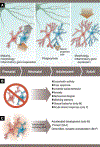Small cells with big implications: Microglia and sex differences in brain development, plasticity and behavioral health
- PMID: 30193820
- PMCID: PMC8008579
- DOI: 10.1016/j.pneurobio.2018.09.002
Small cells with big implications: Microglia and sex differences in brain development, plasticity and behavioral health
Abstract
Brain sex differences are programmed largely by sex hormone secretions and direct sex chromosome effects in early life, and are subsequently modulated by early life experiences. The brain's resident immune cells, called microglia, actively contribute to brain development. Recent research has shown that microglia are sexually dimorphic, especially during early life, and may participate in sex-specific organization of the brain and behavior. Likewise, sex differences in immune cells and their signaling in the adult brain have been found, although in most cases their function remains unclear. Additionally, immune cells and their signaling have been implicated in many disorders in which brain development or plasticity is altered, including autism, schizophrenia, pain disorders, major depression, and postpartum depression. This review summarizes what is currently known about sex differences in neuroimmune function in development and during other major phases of brain plasticity, as well as the current state of knowledge regarding sex-specific neuroimmune function in psychiatric disorders.
Keywords: Astrocyte; Autism; Behavior; Development; Hormone; Immune; Inflammation; Microglia; Mood disorders; Sex; Sex differences; Stress.
Copyright © 2018 Elsevier Ltd. All rights reserved.
Figures


Similar articles
-
A starring role for microglia in brain sex differences.Neuroscientist. 2015 Jun;21(3):306-21. doi: 10.1177/1073858414536468. Epub 2014 May 28. Neuroscientist. 2015. PMID: 24871624 Free PMC article. Review.
-
Sex, glia, and development: interactions in health and disease.Horm Behav. 2012 Aug;62(3):243-53. doi: 10.1016/j.yhbeh.2012.02.018. Epub 2012 Feb 22. Horm Behav. 2012. PMID: 22387107 Free PMC article. Review.
-
(Putative) sex differences in neuroimmune modulation of memory.J Neurosci Res. 2017 Jan 2;95(1-2):472-486. doi: 10.1002/jnr.23921. J Neurosci Res. 2017. PMID: 27870428 Free PMC article. Review.
-
Neuroimmune mechanisms of stress: sex differences, developmental plasticity, and implications for pharmacotherapy of stress-related disease.Stress. 2015;18(4):367-80. doi: 10.3109/10253890.2015.1053451. Epub 2015 Jul 15. Stress. 2015. PMID: 26176590 Free PMC article. Review.
-
Neuroimmune Mechanisms and Sex/Gender-Dependent Effects in the Pathophysiology of Mental Disorders.J Pharmacol Exp Ther. 2020 Oct;375(1):175-192. doi: 10.1124/jpet.120.266163. Epub 2020 Jul 13. J Pharmacol Exp Ther. 2020. PMID: 32661057 Free PMC article. Review.
Cited by
-
Bioinformatics analysis of diagnostic biomarkers for Alzheimer's disease in peripheral blood based on sex differences and support vector machine algorithm.Hereditas. 2022 Oct 4;159(1):38. doi: 10.1186/s41065-022-00252-x. Hereditas. 2022. PMID: 36195955 Free PMC article.
-
Frank Beach Award Winner - The future of mental health research: Examining the interactions of the immune, endocrine and nervous systems between mother and infant and how they affect mental health.Horm Behav. 2019 Aug;114:104521. doi: 10.1016/j.yhbeh.2019.04.008. Epub 2019 Apr 18. Horm Behav. 2019. PMID: 30981689 Free PMC article. Review.
-
Transcriptional and epigenetic regulation of microglia in substance use disorders.Mol Cell Neurosci. 2023 Jun;125:103838. doi: 10.1016/j.mcn.2023.103838. Epub 2023 Mar 7. Mol Cell Neurosci. 2023. PMID: 36893849 Free PMC article. Review.
-
Ontogeny and programming of the fetal temporal cortical endocannabinoid system by moderate maternal nutrient reduction in baboons (Papio spp.).Physiol Rep. 2019 Mar;7(6):e14024. doi: 10.14814/phy2.14024. Physiol Rep. 2019. PMID: 30912236 Free PMC article.
-
Sex and Region-Specific Differences in Microglial Morphology and Function Across Development.Neuroglia. 2025 Mar;6(1):2. doi: 10.3390/neuroglia6010002. Epub 2025 Jan 4. Neuroglia. 2025. PMID: 40181886 Free PMC article.
References
-
- Abiega O, Beccari S, Diaz-Aparicio I, Nadjar A, Layé S, Leyrolle Q, Gómez-Nicola D, Domercq M, Pérez-Samartín A, Sánchez-Zafra V, Paris I, Valero J, Savage JC, Hui C-W, Tremblay M-È, Deudero JJP, Brewster AL, Anderson AE, Zaldumbide L, Galbarriatu L, Marinas A, Vivanco M, Matute C, Maletic-Savatic M, Encinas JM, Sierra A, 2016. Neuronal Hyperactivity Disturbs ATP Microgradients, Impairs Microglial Motility, and Reduces Phagocytic Receptor Expression Triggering Apoptosis/Microglial Phagocytosis Uncoupling. PLOS Biol 14, e1002466. 10.1371/journal.pbio.1002466 - DOI - PMC - PubMed
Publication types
MeSH terms
Grants and funding
LinkOut - more resources
Full Text Sources
Other Literature Sources

